Multi-Prior Graph Autoencoder with Ranking-Based Band Selection for Hyperspectral Anomaly Detection
Abstract
:1. Introduction
- 1
- The MPGAE is proposed to handle the situations where anomalies are present in hyperspectral images. Based on the piecewise-smooth prior, the band selection module can eliminate the unnecessary spectral bands to improve the performance.
- 2
- Based on the combination of a global RX detector and local salient weight, a new loss function is presented. The loss function can improve performance by adjusting background and anomaly feature learning.
- 3
- The supergraph [52] is introduced into autoencoder for preserving spatial consistency and information about the local geometric structure, which can improve the robustness of the proposed MPGAE.
2. Proposed Method
2.1. Overview
2.2. Ranking-Based Band Selection with Piecewise-Smooth Prior
2.3. Adaptive Weight Based on Salient Prior
2.4. Graph Autoencoder
2.5. Loss Function
| Algorithm 1 The Proposed HAD Method |
Input:
|
3. Experimental Results and Discussion
3.1. Datasets Description
3.2. Performance Evaluation Metrics
3.3. Ablation Study
3.3.1. Parameter Sensitivity Analysis
3.3.2. Component Analysis
3.4. Detection Performance Comparison
3.4.1. San Diego
3.4.2. Pavia Center
3.4.3. Texas Coast-1
3.4.4. Texas Coast-2
3.4.5. Los Angeles
4. Conclusions
Author Contributions
Funding
Data Availability Statement
Conflicts of Interest
References
- Goetz, A.F.; Vane, G.; Solomon, J.E.; Rock, B.N. Imaging spectrometry for earth remote sensing. Science 1985, 228, 1147–1153. [Google Scholar] [CrossRef]
- Lin, M.; Yang, G.; Zhang, H. Transition is a process: Pair-to-video change detection networks for very high resolution remote sensing images. IEEE Trans. Image Process. 2022, 32, 57–71. [Google Scholar] [CrossRef] [PubMed]
- Tong, X.; Pan, H.; Liu, S.; Li, B.; Luo, X.; Xie, H.; Xu, X. A novel approach for hyperspectral change detection based on uncertain area analysis and improved transfer learning. IEEE J. Sel. Top. Appl. Earth Obs. Remote Sens. 2020, 13, 2056–2069. [Google Scholar] [CrossRef]
- Liu, S.; Song, L.; Li, H.; Chen, J.; Zhang, G.; Hu, B.; Wang, S.; Li, S. Spatial weighted kernel spectral angle constraint method for hyperspectral change detection. J. Appl. Remote Sens. 2022, 16, 016503. [Google Scholar] [CrossRef]
- Liu, S.; Li, H.; Chen, J.; Li, S.; Song, L.; Zhang, G.; Hu, B. Adaptive convolution kernel network for change detection in hyperspectral images. Appl. Opt. 2023, 62, 2039–2047. [Google Scholar] [CrossRef]
- Fang, J.; Cao, X. Multidimensional relation learning for hyperspectral image classification. Neurocomputing 2020, 410, 211–219. [Google Scholar] [CrossRef]
- Shi, Y.; Fu, B.; Wang, N.; Cheng, Y.; Fang, J.; Liu, X.; Zhang, G. Spectral-Spatial Attention Rotation-Invariant Classification Network for Airborne Hyperspectral Images. Drones 2023, 7, 240. [Google Scholar] [CrossRef]
- Zhang, X.; Yang, S.; Feng, Z.; Song, L.; Wei, Y.; Jiao, L. Triple Contrastive Representation Learning for Hyperspectral Image Classification with Noisy Labels. IEEE Trans. Geosci. Remote Sens. 2023. [Google Scholar] [CrossRef]
- Chen, Y.; Huang, J.; Mou, L.; Jin, P.; Xiong, S.; Zhu, X.X. Deep Saliency Smoothing Hashing for Drone Image Retrieval. IEEE Trans. Geosci. Remote Sens. 2023, 61, 4700913. [Google Scholar] [CrossRef]
- Zhang, X.; Fan, X.; Wang, G.; Chen, P.; Tang, X.; Jiao, L. MFGNet: Multibranch Feature Generation Networks for Few-Shot Remote Sensing Scene Classification. IEEE Trans. Geosci. Remote Sens. 2023, 61, 5609613. [Google Scholar] [CrossRef]
- Li, Y.; Chen, R.; Zhang, Y.; Zhang, M.; Chen, L. Multi-label remote sensing image scene classification by combining a convolutional neural network and a graph neural network. Remote Sens. 2020, 12, 4003. [Google Scholar] [CrossRef]
- Wang, N.; Shi, Y.; Yang, F.; Zhang, G.; Li, S.; Liu, X. Collaborative representation with multipurification processing and local salient weight for hyperspectral anomaly detection. J. Appl. Remote Sens. 2022, 16, 036517. [Google Scholar] [CrossRef]
- Yao, Y.; Wang, M.; Fan, G.; Liu, W.; Ma, Y.; Mei, X. Dictionary Learning-Cooperated Matrix Decomposition for Hyperspectral Target Detection. Remote Sens. 2022, 14, 4369. [Google Scholar] [CrossRef]
- Nassif, A.B.; Talib, M.A.; Nasir, Q.; Dakalbab, F.M. Machine learning for anomaly detection: A systematic review. IEEE Access 2021, 9, 78658–78700. [Google Scholar] [CrossRef]
- Xia, X.; Pan, X.; Li, N.; He, X.; Ma, L.; Zhang, X.; Ding, N. GAN-based anomaly detection: A review. Neurocomputing 2022, 493, 497–535. [Google Scholar] [CrossRef]
- Wang, S.; Wang, X.; Zhong, Y.; Zhang, L. Hyperspectral anomaly detection via locally enhanced low-rank prior. IEEE Trans. Geosci. Remote Sens. 2020, 58, 6995–7009. [Google Scholar] [CrossRef]
- Jiang, K.; Xie, W.; Lei, J.; Li, Z.; Li, Y.; Jiang, T.; Du, Q. E2E-LIADE: End-to-end local invariant autoencoding density estimation model for anomaly target detection in hyperspectral image. IEEE Trans. Cybern. 2021, 52, 11385–11396. [Google Scholar] [CrossRef]
- Chang, C.I.; Chiang, S.S. Anomaly detection and classification for hyperspectral imagery. IEEE Trans. Geosci. Remote Sens. 2002, 40, 1314–1325. [Google Scholar] [CrossRef]
- Xu, Y.; Wu, Z.; Li, J.; Plaza, A.; Wei, Z. Anomaly detection in hyperspectral images based on low-rank and sparse representation. IEEE Trans. Geosci. Remote Sens. 2015, 54, 1990–2000. [Google Scholar] [CrossRef]
- Zhang, X.; Ma, X.; Huyan, N.; Gu, J.; Tang, X.; Jiao, L. Spectral-difference low-rank representation learning for hyperspectral anomaly detection. IEEE Trans. Geosci. Remote Sens. 2021, 59, 10364–10377. [Google Scholar] [CrossRef]
- Wu, Z.; Su, H.; Tao, X.; Han, L.; Paoletti, M.E.; Haut, J.M.; Plaza, J.; Plaza, A. Hyperspectral anomaly detection with relaxed collaborative representation. IEEE Trans. Geosci. Remote Sens. 2022, 60, 5533417. [Google Scholar] [CrossRef]
- Matteoli, S.; Diani, M.; Corsini, G. A tutorial overview of anomaly detection in hyperspectral images. IEEE Aerosp. Electron. Syst. Mag. 2010, 25, 5–28. [Google Scholar] [CrossRef]
- Du, B.; Zhang, L. A discriminative metric learning based anomaly detection method. IEEE Trans. Geosci. Remote Sens. 2014, 52, 6844–6857. [Google Scholar]
- Huyan, N.; Zhang, X.; Zhou, H.; Jiao, L. Hyperspectral anomaly detection via background and potential anomaly dictionaries construction. IEEE Trans. Geosci. Remote Sens. 2018, 57, 2263–2276. [Google Scholar] [CrossRef]
- Tao, R.; Zhao, X.; Li, W.; Li, H.C.; Du, Q. Hyperspectral anomaly detection by fractional Fourier entropy. IEEE J. Sel. Top. Appl. Earth Obs. Remote Sens. 2019, 12, 4920–4929. [Google Scholar] [CrossRef]
- Reed, I.S.; Yu, X. Adaptive multiple-band CFAR detection of an optical pattern with unknown spectral distribution. IEEE Trans. Acoust. Speech Signal Process. 1990, 38, 1760–1770. [Google Scholar] [CrossRef]
- Molero, J.M.; Garzon, E.M.; Garcia, I.; Plaza, A. Analysis and optimizations of global and local versions of the RX algorithm for anomaly detection in hyperspectral data. IEEE J. Sel. Top. Appl. Earth Obs. Remote Sens. 2013, 6, 801–814. [Google Scholar] [CrossRef]
- Zhao, C.; Wang, Y.; Qi, B.; Wang, J. Global and local real-time anomaly detectors for hyperspectral remote sensing imagery. Remote Sens. 2015, 7, 3966–3985. [Google Scholar] [CrossRef]
- Kwon, H.; Nasrabadi, N.M. Kernel RX-algorithm: A nonlinear anomaly detector for hyperspectral imagery. IEEE Trans. Geosci. Remote Sens. 2005, 43, 388–397. [Google Scholar] [CrossRef]
- Gu, Y.; Liu, Y.; Zhang, Y. A selective KPCA algorithm based on high-order statistics for anomaly detection in hyperspectral imagery. IEEE Geosci. Remote Sens. Lett. 2008, 5, 43–47. [Google Scholar] [CrossRef]
- Zhou, J.; Kwan, C.; Ayhan, B.; Eismann, M.T. A novel cluster kernel RX algorithm for anomaly and change detection using hyperspectral images. IEEE Trans. Geosci. Remote Sens. 2016, 54, 6497–6504. [Google Scholar] [CrossRef]
- He, F.; Yan, S.; Ding, Y.; Sun, Z.; Zhao, J.; Hu, H.; Zhu, Y. Recursive RX with Extended Multi-Attribute Profiles for Hyperspectral Anomaly Detection. Remote Sens. 2023, 15, 589. [Google Scholar] [CrossRef]
- Carlotto, M.J. A cluster-based approach for detecting human-made objects and changes in imagery. IEEE Trans. Geosci. Remote Sens. 2005, 43, 374–387. [Google Scholar] [CrossRef]
- Li, S.; Zhang, K.; Duan, P.; Kang, X. Hyperspectral anomaly detection with kernel isolation forest. IEEE Trans. Geosci. Remote Sens. 2019, 58, 319–329. [Google Scholar] [CrossRef]
- Song, X.; Aryal, S.; Ting, K.M.; Liu, Z.; He, B. Spectral–spatial anomaly detection of hyperspectral data based on improved isolation forest. IEEE Trans. Geosci. Remote Sens. 2021, 60, 1–16. [Google Scholar] [CrossRef]
- Zhang, L.; Yang, M.; Feng, X. Sparse representation or collaborative representation: Which helps face recognition? In Proceedings of the 2011 International Conference on Computer Vision, Barcelona, Spain, 6–13 November 2011; IEEE: Piscataway, NJ, USA, 2011; pp. 471–478. [Google Scholar]
- Li, W.; Du, Q. Collaborative representation for hyperspectral anomaly detection. IEEE Trans. Geosci. Remote Sens. 2014, 53, 1463–1474. [Google Scholar] [CrossRef]
- Chang, S.; Ghamisi, P. Nonnegative-Constrained Joint Collaborative Representation With Union Dictionary for Hyperspectral Anomaly Detection. IEEE Trans. Geosci. Remote Sens. 2022, 60, 1–13. [Google Scholar] [CrossRef]
- Li, J.; Zhang, H.; Zhang, L.; Ma, L. Hyperspectral anomaly detection by the use of background joint sparse representation. IEEE J. Sel. Top. Appl. Earth Obs. Remote Sens. 2015, 8, 2523–2533. [Google Scholar] [CrossRef]
- Zhao, R.; Du, B.; Zhang, L.; Zhang, L. A robust background regression based score estimation algorithm for hyperspectral anomaly detection. ISPRS J. Photogramm. Remote Sens. 2016, 122, 126–144. [Google Scholar] [CrossRef]
- Liu, G.; Lin, Z.; Yan, S.; Sun, J.; Yu, Y.; Ma, Y. Robust recovery of subspace structures by low-rank representation. IEEE Trans. Pattern Anal. Mach. Intell. 2012, 35, 171–184. [Google Scholar] [CrossRef]
- Sun, S.; Liu, J.; Zhang, Z.; Li, W. Hyperspectral Anomaly Detection Based on Adaptive Low-Rank Transformed Tensor. IEEE Trans. Neural Netw. Learn. Syst. 2023. early access. [Google Scholar] [CrossRef] [PubMed]
- Qu, Y.; Wang, W.; Guo, R.; Ayhan, B.; Kwan, C.; Vance, S.; Qi, H. Hyperspectral anomaly detection through spectral unmixing and dictionary-based low-rank decomposition. IEEE Trans. Geosci. Remote Sens. 2018, 56, 4391–4405. [Google Scholar] [CrossRef]
- Qu, Y.; Guo, R.; Wang, W.; Qi, H.; Ayhan, B.; Kwan, C.; Vance, S. Anomaly detection in hyperspectral images through spectral unmixing and low rank decomposition. In Proceedings of the 2016 IEEE International Geoscience and Remote Sensing Symposium (IGARSS), Beijing, China, 10–15 July 2016; IEEE: Piscataway, NJ, USA, 2016; pp. 1855–1858. [Google Scholar]
- Song, D.; Dong, Y.; Li, X. Hierarchical edge refinement network for saliency detection. IEEE Trans. Image Process. 2021, 30, 7567–7577. [Google Scholar] [CrossRef] [PubMed]
- Song, D.; Dong, Y.; Li, X. Context and Difference Enhancement Network for Change Detection. IEEE J. Sel. Top. Appl. Earth Obs. Remote Sens. 2022, 15, 9457–9467. [Google Scholar] [CrossRef]
- Li, W.; Wu, G.; Du, Q. Transferred deep learning for anomaly detection in hyperspectral imagery. IEEE Geosci. Remote. Sens. Lett. 2017, 14, 597–601. [Google Scholar] [CrossRef]
- Creswell, A.; Bharath, A.A. Denoising adversarial autoencoders. IEEE Trans. Neural Netw. Learn. Syst. 2018, 30, 968–984. [Google Scholar] [CrossRef]
- Zhao, C.; Zhang, L. Spectral-spatial stacked autoencoders based on low-rank and sparse matrix decomposition for hyperspectral anomaly detection. Infrared Phys. Technol. 2018, 92, 166–176. [Google Scholar] [CrossRef]
- Xie, W.; Lei, J.; Liu, B.; Li, Y.; Jia, X. Spectral constraint adversarial autoencoders approach to feature representation in hyperspectral anomaly detection. Neural Netw. 2019, 119, 222–234. [Google Scholar] [CrossRef]
- Wang, S.; Wang, X.; Zhang, L.; Zhong, Y. Auto-AD: Autonomous hyperspectral anomaly detection network based on fully convolutional autoencoder. IEEE Trans. Geosci. Remote Sens. 2021, 60, 5503314. [Google Scholar] [CrossRef]
- Fan, G.; Ma, Y.; Mei, X.; Fan, F.; Huang, J.; Ma, J. Hyperspectral anomaly detection with robust graph autoencoders. IEEE Trans. Geosci. Remote. Sens. 2021, 60, 5511314. [Google Scholar]
- Xiang, P.; Ali, S.; Jung, S.K.; Zhou, H. Hyperspectral anomaly detection with guided autoencoder. IEEE Trans. Geosci. Remote Sens. 2022, 60, 5538818. [Google Scholar] [CrossRef]
- He, K.; Sun, W.; Yang, G.; Meng, X.; Ren, K.; Peng, J.; Du, Q. A dual global–local attention network for hyperspectral band selection. IEEE Trans. Geosci. Remote Sens. 2022, 60, 5527613. [Google Scholar] [CrossRef]
- Wang, Q.; Li, Q.; Li, X. Hyperspectral band selection via adaptive subspace partition strategy. IEEE J. Sel. Top. Appl. Earth Obs. Remote Sens. 2019, 12, 4940–4950. [Google Scholar] [CrossRef]
- Xie, W.; Lei, J.; Yang, J.; Li, Y.; Du, Q.; Li, Z. Deep latent spectral representation learning-based hyperspectral band selection for target detection. IEEE Trans. Geosci. Remote Sens. 2019, 58, 2015–2026. [Google Scholar] [CrossRef]
- Jiao, C.; Chen, C.; McGarvey, R.G.; Bohlman, S.; Jiao, L.; Zare, A. Multiple instance hybrid estimator for hyperspectral target characterization and sub-pixel target detection. ISPRS J. Photogramm. Remote Sens. 2018, 146, 235–250. [Google Scholar] [CrossRef]
- Ye, F.; Huang, C.; Cao, J.; Li, M.; Zhang, Y.; Lu, C. Attribute restoration framework for anomaly detection. IEEE Trans. Multimed. 2020, 24, 116–127. [Google Scholar] [CrossRef]
- Li, L.; Li, W.; Qu, Y.; Zhao, C.; Tao, R.; Du, Q. Prior-based tensor approximation for anomaly detection in hyperspectral imagery. IEEE Trans. Neural Netw. Learn. Syst. 2020, 33, 1037–1050. [Google Scholar] [CrossRef]
- Achanta, R.; Shaji, A.; Smith, K.; Lucchi, A.; Fua, P.; Süsstrunk, S. SLIC superpixels compared to state-of-the-art superpixel methods. IEEE Trans. Pattern Anal. Mach. Intell. 2012, 34, 2274–2282. [Google Scholar] [CrossRef]
- Su, H.; Wu, Z.; Zhang, H.; Du, Q. Hyperspectral anomaly detection: A survey. IEEE Geosci. Remote Sens. Mag. 2021, 10, 64–90. [Google Scholar] [CrossRef]
- Li, J.; Zhang, H.; Zhang, L. Efficient superpixel-level multitask joint sparse representation for hyperspectral image classification. IEEE Trans. Geosci. Remote Sens. 2015, 53, 5338–5351. [Google Scholar]
- Li, Z.; Liu, J.; Tang, J.; Lu, H. Robust structured subspace learning for data representation. IEEE Trans. Pattern Anal. Mach. Intell. 2015, 37, 2085–2098. [Google Scholar] [CrossRef] [PubMed]
- Ding, C.; Zhou, D.; He, X.; Zha, H. R 1-pca: Rotational invariant l 1-norm principal component analysis for robust subspace factorization. In Proceedings of the 23rd International Conference on Machine Learning, Pittsburgh, PA, USA, 25–29 June 2006; pp. 281–288. [Google Scholar]
- Kang, X.; Zhang, X.; Li, S.; Li, K.; Li, J.; Benediktsson, J.A. Hyperspectral anomaly detection with attribute and edge-preserving filters. IEEE Trans. Geosci. Remote Sens. 2017, 55, 5600–5611. [Google Scholar] [CrossRef]
- Zweig, M.H.; Campbell, G. Receiver-operating characteristic (ROC) plots: A fundamental evaluation tool in clinical medicine. Clin. Chem. 1993, 39, 561–577. [Google Scholar] [CrossRef] [PubMed]
- Ferri, C.; Hernández-Orallo, J.; Flach, P.A. A coherent interpretation of AUC as a measure of aggregated classification performance. In Proceedings of the 28th International Conference on Machine Learning (ICML-11), Bellevue, WA, USA, 28 June–2 July 2011; pp. 657–664. [Google Scholar]
- Ma, Y.; Fan, G.; Jin, Q.; Huang, J.; Mei, X.; Ma, J. Hyperspectral anomaly detection via integration of feature extraction and background purification. IEEE Geosci. Remote Sens. Lett. 2020, 18, 1436–1440. [Google Scholar] [CrossRef]

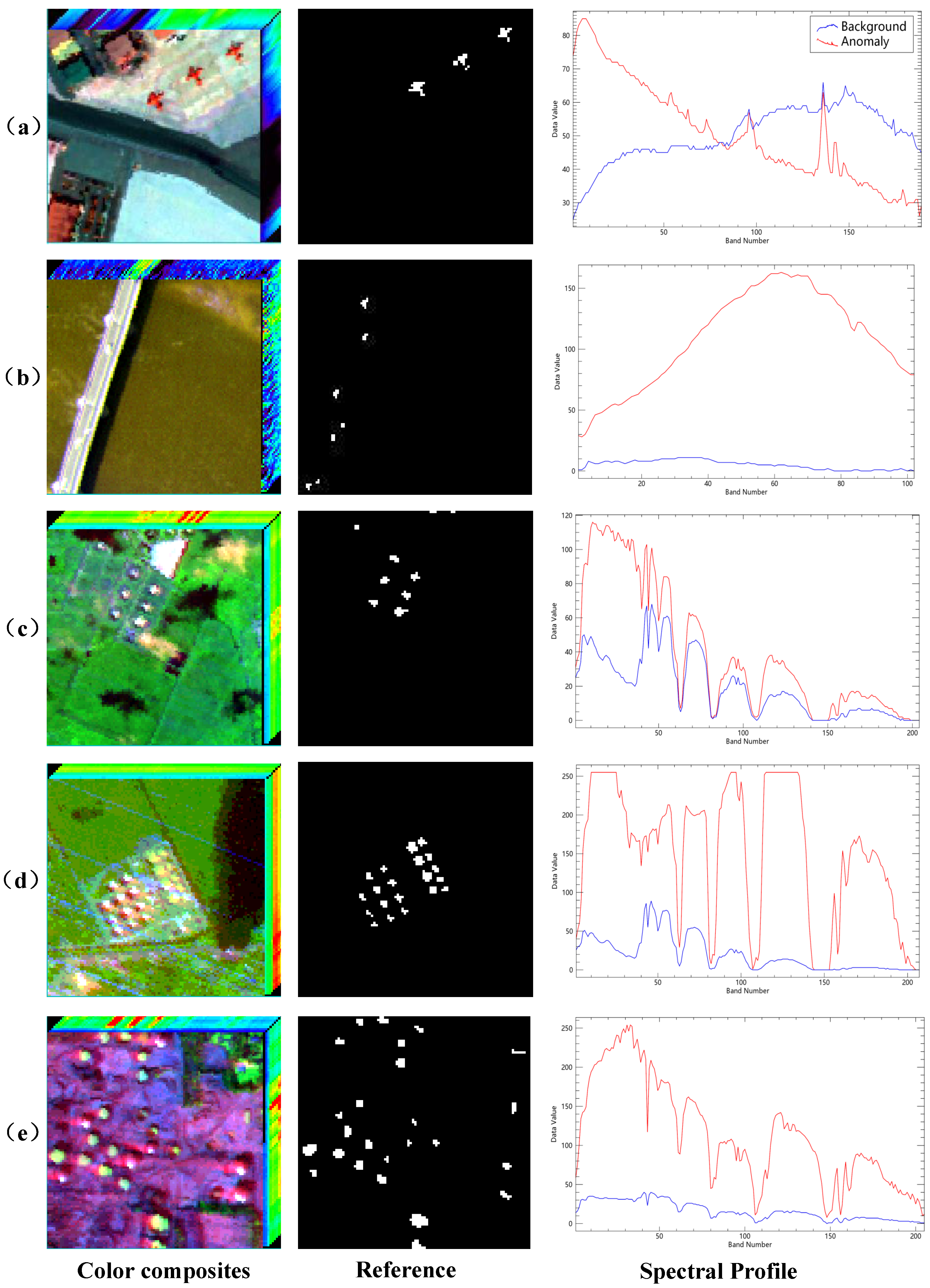
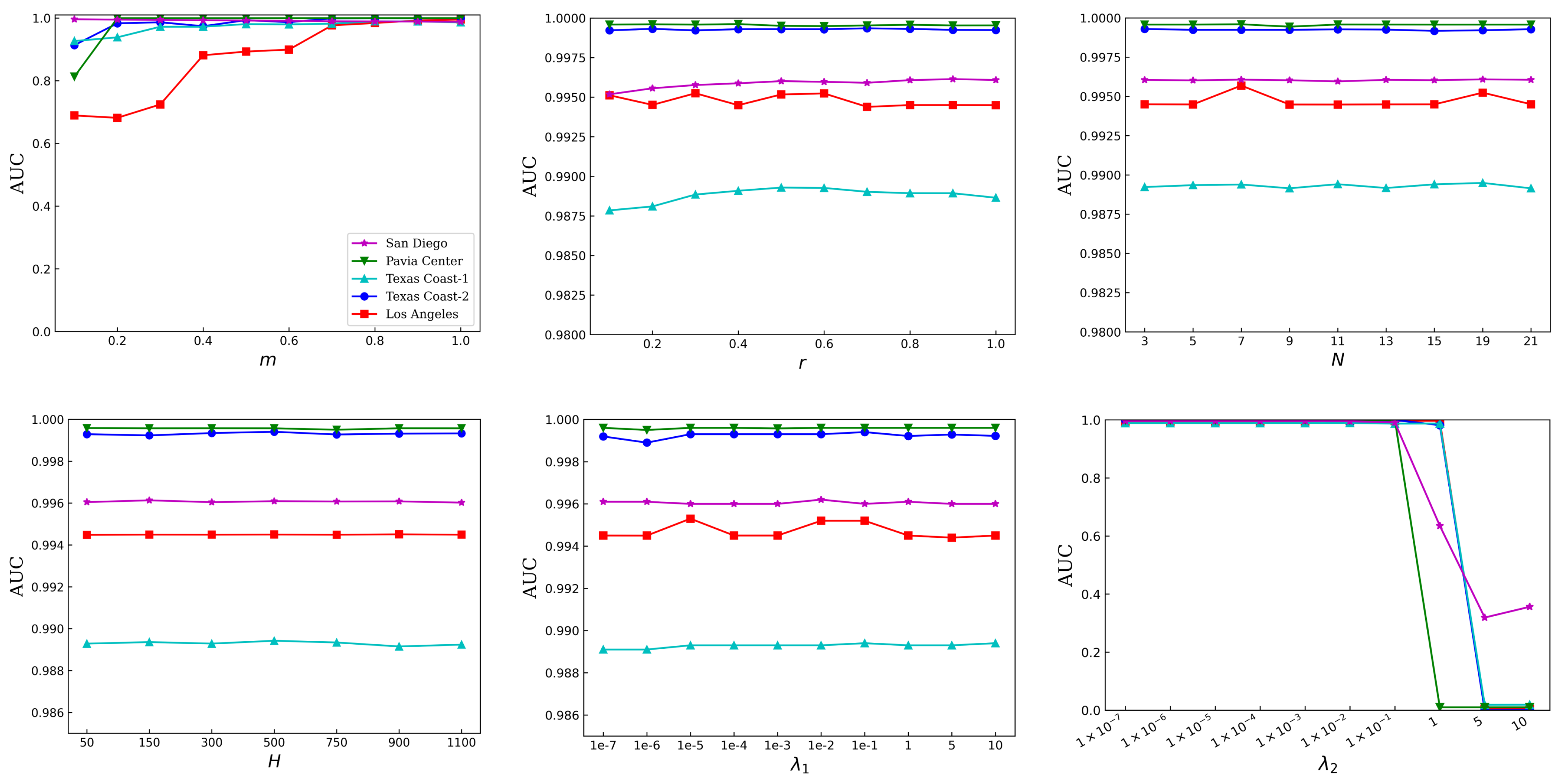
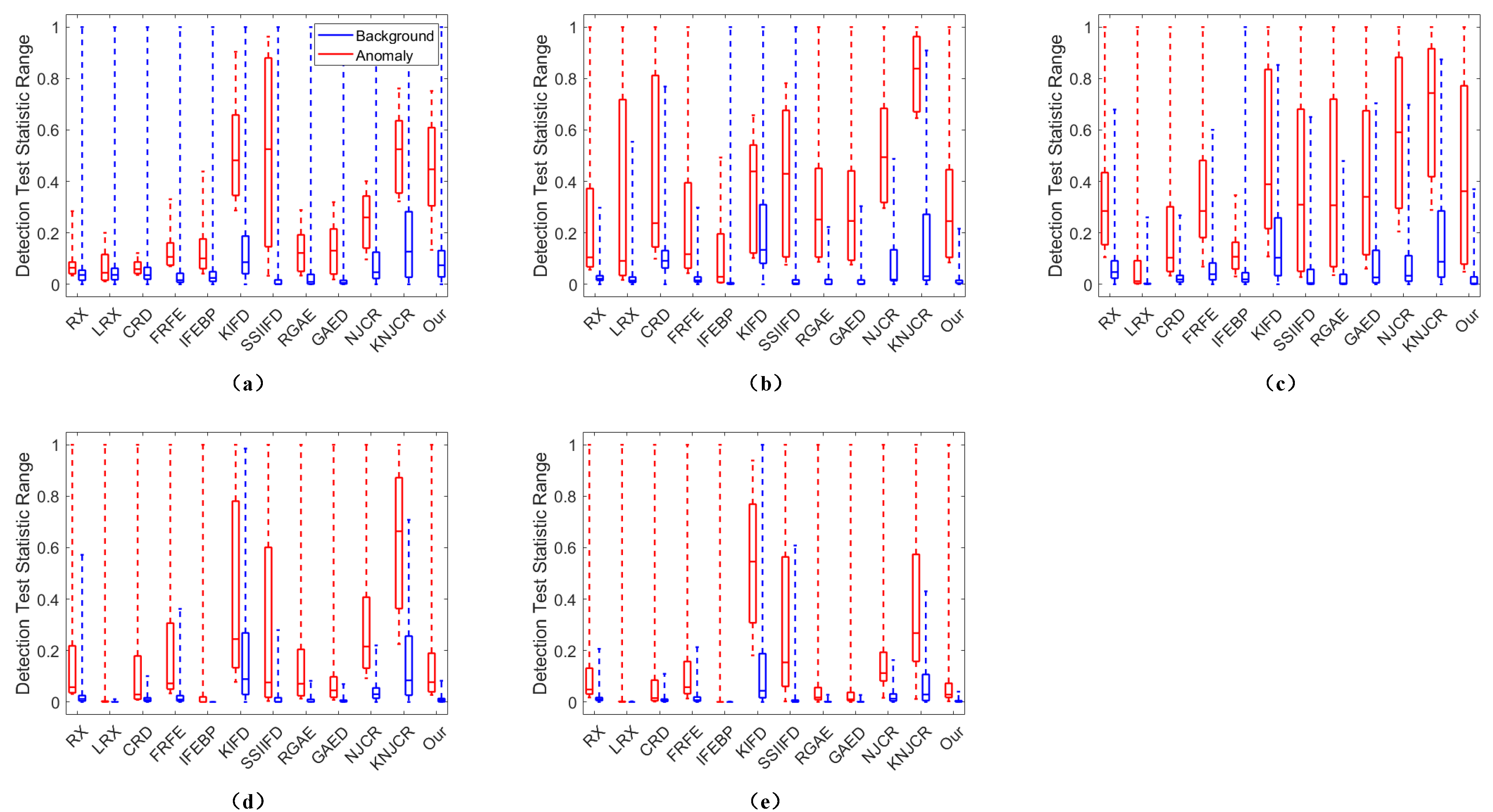
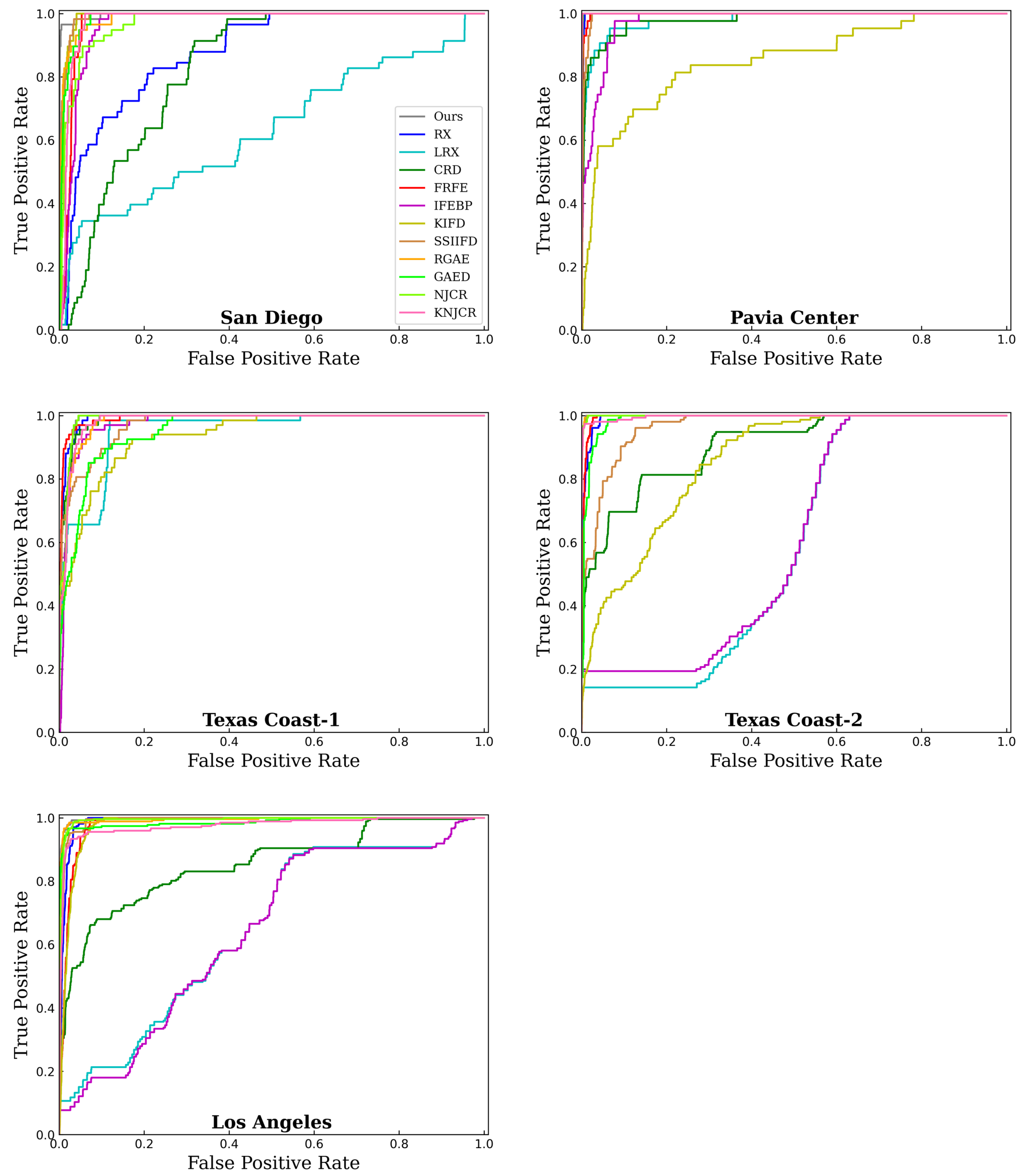
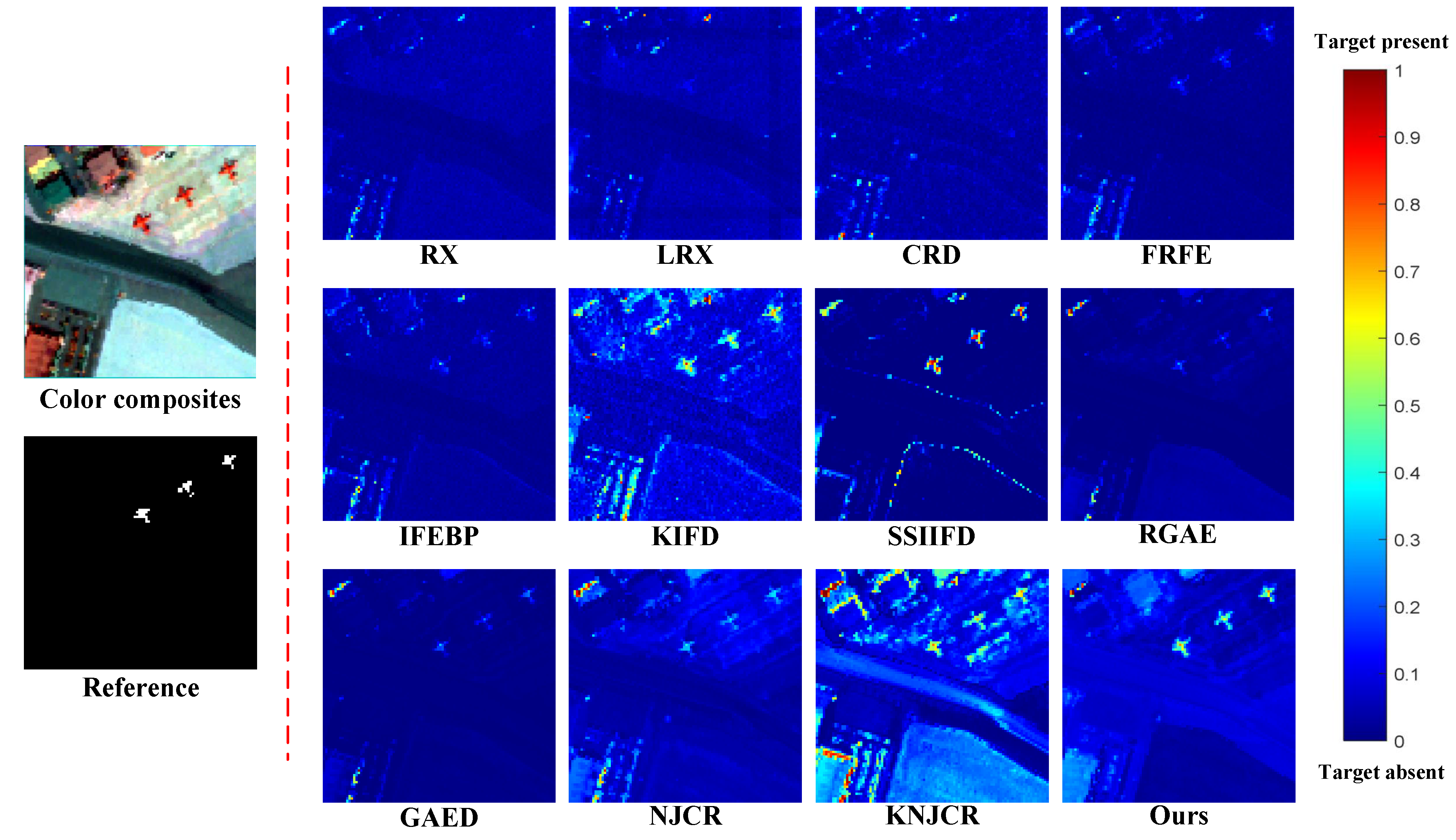

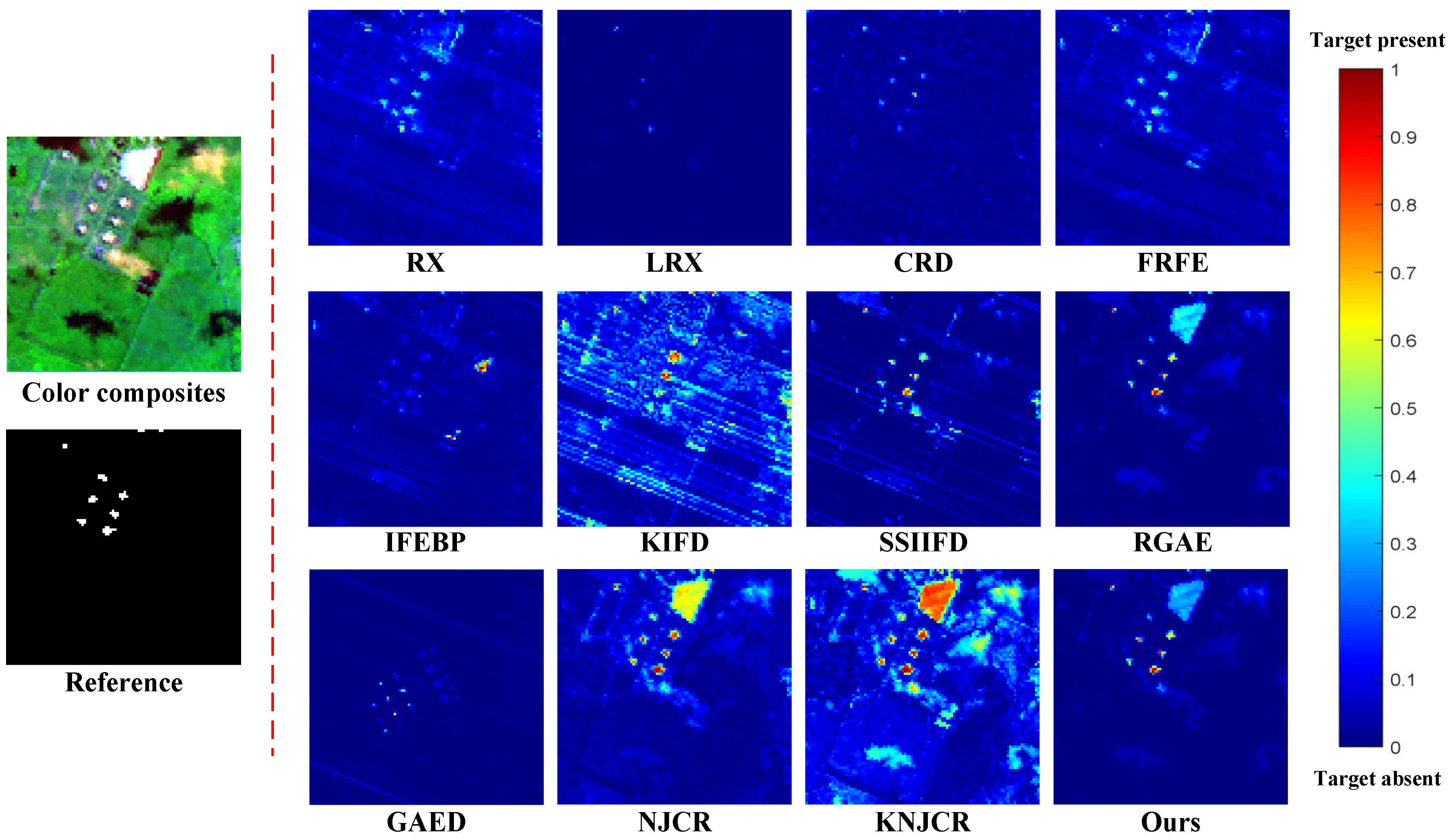

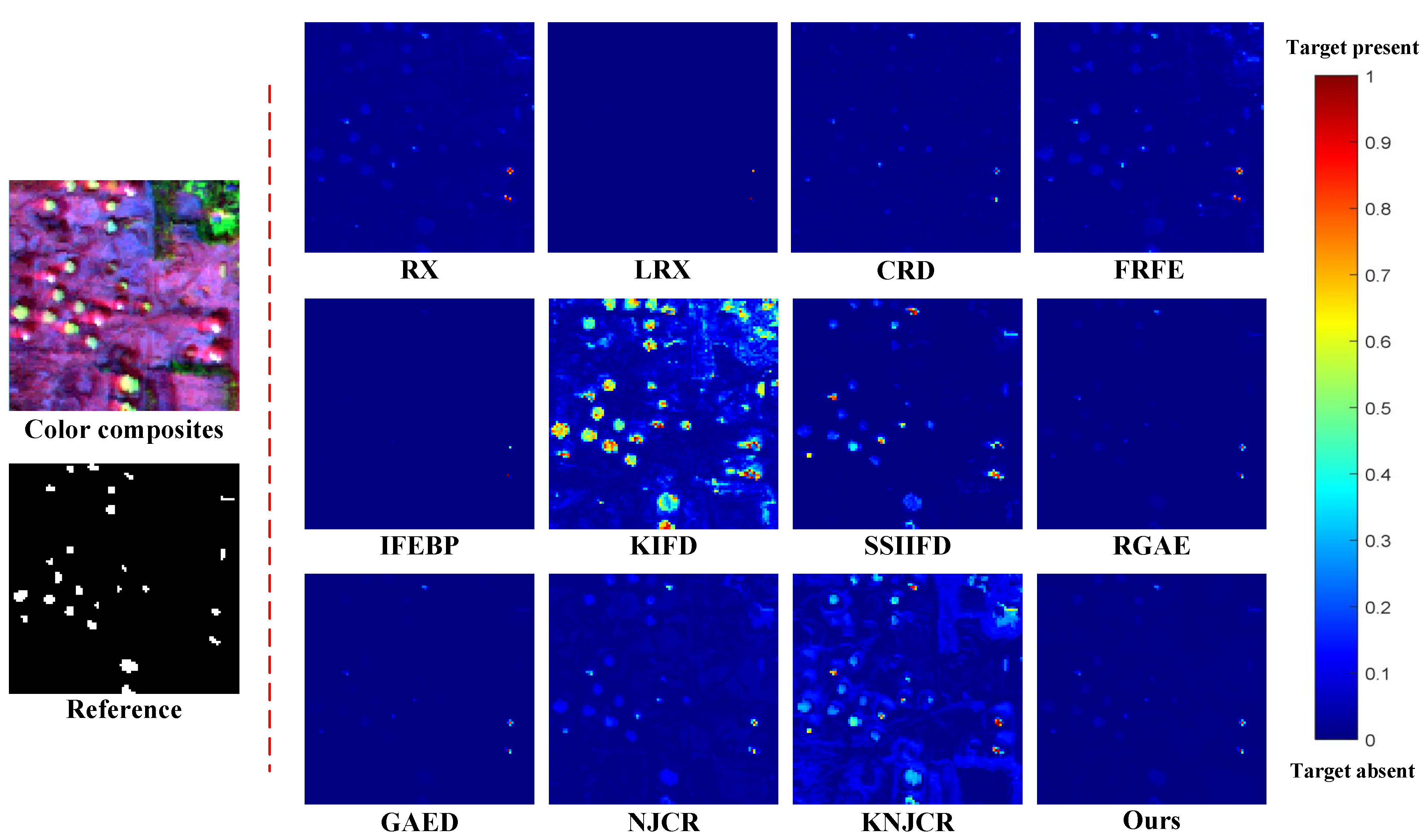
| Dataset | Sensor | Resolution | Spatial Size | Bands | Type | Proportion | Average Size |
|---|---|---|---|---|---|---|---|
| San Diego | AVIRIS | 3.5 m | 189 | aircraft | 0.57% | 19 | |
| Pavia Center | ROSIS | 1.3 m | 102 | automobiles | 0.13% | 3 | |
| Texas Coast-1 | AVIRIS | 17.2 m | 204 | buildings | 0.67% | 8 | |
| Texas Coast-2 | AVIRIS | 17.2 m | 207 | buildings | 1.55% | 9 | |
| Los Angeles | AVIRIS | 7.1 m | 205 | oil tanks | 2.72% | 11 |
| Dataset | m | r | N | H | AUC | ||
|---|---|---|---|---|---|---|---|
| San Diego | 0.1 | 0.8 | 3 | 50 | 0.9965 | ||
| Pavia Center | 0.8 | 0.1 | 3 | 50 | 0.9997 | ||
| Texas Coast-1 | 0.8 | 0.5 | 19 | 500 | 0.9895 | ||
| Texas Coast-2 | 0.8 | 0.7 | 7 | 500 | 0.9994 | ||
| Los Angeles | 1 | 0.3 | 7 | 750 | 1 | 0.9969 |
| Dataset | AE | RBSPP | AWBSP | GR | AUC |
|---|---|---|---|---|---|
| San Diego | ✔ | 0.9689 | |||
| ✔ | ✔ | 0.9860 | |||
| ✔ | ✔ | ✔ | 0.9958 | ||
| ✔ | ✔ | ✔ | ✔ | 0.9965 | |
| Pavia Center | ✔ | 0.9994 | |||
| ✔ | ✔ | 0.9996 | |||
| ✔ | ✔ | ✔ | 0.9996 | ||
| ✔ | ✔ | ✔ | ✔ | 0.9997 | |
| Texas Coast-1 | ✔ | 0.9876 | |||
| ✔ | ✔ | 0.9889 | |||
| ✔ | ✔ | ✔ | 0.9892 | ||
| ✔ | ✔ | ✔ | ✔ | 0.9895 | |
| Texas Coast-2 | ✔ | 0.9989 | |||
| ✔ | ✔ | 0.9987 | |||
| ✔ | ✔ | ✔ | 0.9993 | ||
| ✔ | ✔ | ✔ | ✔ | 0.9994 | |
| Los Angeles | ✔ | 0.9895 | |||
| ✔ | ✔ | 0.9931 | |||
| ✔ | ✔ | ✔ | 0.9945 | ||
| ✔ | ✔ | ✔ | ✔ | 0.9969 |
| Methods | San Diego | Pavia Center | Texas Coast-1 | Texas Coast-2 | Los Angeles | Average |
|---|---|---|---|---|---|---|
| RX | 0.8789 | 0.9982 | 0.9908 | 0.9939 | 0.9893 | 0.9702 |
| LRX | 0.6313 | 0.9792 | 0.9512 | 0.5848 | 0.6497 | 0.7592 |
| CRD | 0.8282 | 0.9791 | 0.9878 | 0.9048 | 0.8523 | 0.9104 |
| FRFE | 0.9741 | 0.9978 | 0.9916 | 0.9951 | 0.9805 | 0.9878 |
| IFEBP | 0.9641 | 0.9750 | 0.9764 | 0.6042 | 0.6414 | 0.8322 |
| KIFD | 0.9896 | 0.8507 | 0.9416 | 0.8566 | 0.9786 | 0.9234 |
| SSIIFD | 0.9921 | 0.9950 | 0.9719 | 0.9661 | 0.9914 | 0.9833 |
| RGAE | 0.9863 | 0.9997 | 0.9824 | 0.9994 | 0.9945 | 0.9925 |
| GAED | 0.9861 | 0.9994 | 0.9533 | 0.9885 | 0.9865 | 0.9828 |
| NJCR | 0.9709 | 0.9996 | 0.9886 | 0.9992 | 0.9944 | 0.9905 |
| KNJCR | 0.9787 | 0.9996 | 0.9838 | 0.9971 | 0.9772 | 0.9873 |
| MPGAE | 0.9965 | 0.9997 | 0.9895 | 0.9994 | 0.9969 | 0.9964 |
| Methods | San Diego | Pavia Center | Texas Coast-1 | Texas Coast-2 | Los Angeles | Average |
|---|---|---|---|---|---|---|
| RX | 0.09 | 0.03 | 0.28 | 0.16 | 0.25 | 0.16 |
| LRX | 61.20 | 48.41 | 111.83 | 143.53 | 155.90 | 86.84 |
| CRD | 9.77 | 11.75 | 10.16 | 11.72 | 12.66 | 11.21 |
| FRFE | 34.95 | 49.23 | 57.08 | 68.36 | 75.77 | 57.08 |
| IFEBP | 3.00 | 2.11 | 3.53 | 2.77 | 2.69 | 2.82 |
| KIFD | 51.62 | 85.94 | 74.50 | 85.31 | 108.47 | 81.17 |
| SSIIFD | 23.84 | 20.34 | 29.11 | 27.64 | 33.83 | 26.95 |
| RGAE | 57.36 | 49.28 | 47.33 | 66.14 | 65.20 | 43.92 |
| GAED | 85.38 | 107.13 | 61.84 | 81.98 | 85.23 | 84.31 |
| NJCR | 6.5 | 8.13 | 4.72 | 5.39 | 7.02 | 6.35 |
| KNJCR | 37.17 | 44.52 | 30.44 | 32.97 | 39.19 | 36.86 |
| MPGAE | 18.28 | 62.88 | 123.29 | 75.44 | 136.58 | 83.30 |
Disclaimer/Publisher’s Note: The statements, opinions and data contained in all publications are solely those of the individual author(s) and contributor(s) and not of MDPI and/or the editor(s). MDPI and/or the editor(s) disclaim responsibility for any injury to people or property resulting from any ideas, methods, instructions or products referred to in the content. |
© 2023 by the authors. Licensee MDPI, Basel, Switzerland. This article is an open access article distributed under the terms and conditions of the Creative Commons Attribution (CC BY) license (https://creativecommons.org/licenses/by/4.0/).
Share and Cite
Wang, N.; Shi, Y.; Li, H.; Zhang, G.; Li, S.; Liu, X. Multi-Prior Graph Autoencoder with Ranking-Based Band Selection for Hyperspectral Anomaly Detection. Remote Sens. 2023, 15, 4430. https://doi.org/10.3390/rs15184430
Wang N, Shi Y, Li H, Zhang G, Li S, Liu X. Multi-Prior Graph Autoencoder with Ranking-Based Band Selection for Hyperspectral Anomaly Detection. Remote Sensing. 2023; 15(18):4430. https://doi.org/10.3390/rs15184430
Chicago/Turabian StyleWang, Nan, Yuetian Shi, Haiwei Li, Geng Zhang, Siyuan Li, and Xuebin Liu. 2023. "Multi-Prior Graph Autoencoder with Ranking-Based Band Selection for Hyperspectral Anomaly Detection" Remote Sensing 15, no. 18: 4430. https://doi.org/10.3390/rs15184430
APA StyleWang, N., Shi, Y., Li, H., Zhang, G., Li, S., & Liu, X. (2023). Multi-Prior Graph Autoencoder with Ranking-Based Band Selection for Hyperspectral Anomaly Detection. Remote Sensing, 15(18), 4430. https://doi.org/10.3390/rs15184430









